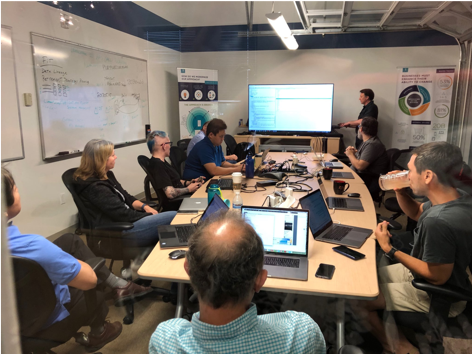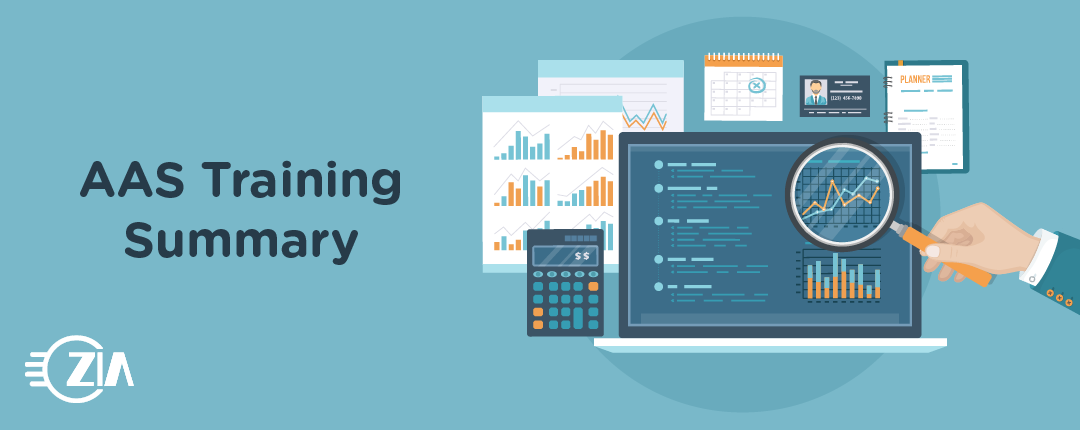On June 27, we welcomed members of the ASG Technologies team to our office in Boulder for training on Audit and Analytics Services (AAS). Our engineering team got an in depth look at the technology and how it can help our customers. The following is a summary of our findings.
What is Audit and Analytics Services?
AAS is a Java application that is designed for coding, running and reporting/auditing, on business assertions about data—usually files.
Data files are things like invoices, bank statements, and accounting reports. Sources of data are not limited to files—they could include things like database queries/results or even API calls/responses. AAS is a fully programmable system, so you could do almost anything with it. However, the key types of logic supported are Control-Totals Balancing and Item Reconciliation.

Bindu Wavell
Zia Consulting, Chief Architect
With Control-Totals Balancing, a single data source is loaded and processed one record at a time. Assertions about each record and possibly about sets of records in aggregate can be coded and ultimately reported upon. For example, you might process all the line items on an invoice and validate that the quantity times the unit price add up to the line item price. Additionally, you could sum up the line item prices and validate they match the final price on the invoice. If validation fails, any number of actions can be taken such as logging the failures, updating external databases indicating the discrepancies, creating excel reports, emailing users to make corrective actions, etc.

Item Reconciliation processes two or more sets of data to find matching, missing, invalid, or mismatched entries. For example, you can reconcile a bank statement against a check register. Items missing from either the bank statement or the check register will be flagged. Also, you can flag items that exist in both data sets but have different amounts.
Business rules are grouped into cycles that cover the same time period. You might have a monthly cycle that updates on the fifteenth of each month. You might have another monthly cycle that updates on the first of the month. You might have a yearly cycle and/or rules that run on a daily cycle. We may run the rules in a cycle several times, either to progressively process new data or to re-process previous data that has been updated once inconsistencies have been remedied.
Each cycle will include detailed information about the rules that have been run, the data that was processed, the results of the processing, and even the code that was evaluated for that run. Rules may also store intermediate or final values in the cycle. Once the processing for a cycle has been completed, we advance to the next cycle and start to process new data for a new time period.
A very powerful feature of the system is that rules in one cycle can interact with data stored in a preceding cycle or even a completely different cycle. For example, we may have a daily cycle that processes daily invoices. We may store a total invoice amount across all invoices in this daily cycle. The monthly cycle may include rules that add up the daily totals to create a monthly total. This could then be compared against an accounting report that lists monthly invoice totals.
Where can this be applied?
Many of the problems AAS helps to solve revolve around financial operations: closing accounting books, automating auditing standards, validating financials earlier, flagging errors earlier so that they can be resolved more quickly, and more. However, one thing to consider is how the product might be applied in various use cases outside of financials.
We can generally describe AAS functionality as the ability to aggregate and reconcile—on an ongoing basis—large volumes of data produced by different applications, on different systems, by different corporate divisions, and at different corporate locations worldwide, and generate consolidated reports from this data. So, consider how it might be used to process data generated and transformed from multiple applications.
What’s next?
Zia is excited to gain more extensive knowledge of AAS and build expertise with the technology. We strongly believe many of our customers will benefit from this solution and we look forward to helping them implement it. If you are interested in learning more about AAS or discussing your project, contact us.

